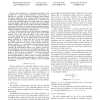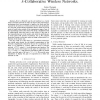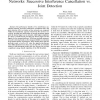1414 search results - page 144 / 283 » Performance Bounds in Communication Networks with Variable-R... |
INFOCOM
2008
IEEE
14 years 3 months ago
2008
IEEE
—Rate allocation is a fundamental problem in the operation of a wireless network because of the necessity to schedule the operation of mutually interfering links between the node...
ICC
2009
IEEE
14 years 3 months ago
2009
IEEE
—How to efficiently use the air interface is a crucial issue in wireless networks. In order to improve the performance, mechanisms have been proposed to improve the reach and th...
INFOCOM
2008
IEEE
14 years 3 months ago
2008
IEEE
— While the practical coding scheme [1] has been shown to be able to improve throughput of wireless networks, there still lacks fundamental understanding on how the coding scheme...
PODC
2010
ACM
14 years 1 months ago
2010
ACM
We study the problem of clock synchronization in highly dynamic networks, where communication links can appear or disappear at any time. The nodes in the network are equipped with...
ICC
2009
IEEE
14 years 3 months ago
2009
IEEE
Abstract—The performance benefits of two interference cancellation methods, successive interference cancellation (SIC) and joint detection (JD), in wireless ad hoc networks are ...



